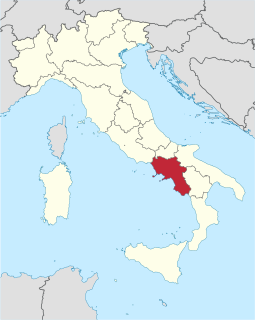 W
WCampania is an administrative region of Italy; most of it is in the south-western portion of the Italian peninsula, but it also includes the small Phlegraean Islands and the island of Capri. The capital of the Campania region is Naples. As of 2018, the region had a population of around 5,820,000 people, making it Italy's third most populous region, and, with an area of 13,590 km2 (5,247 sq mi), its most densely populated region. Based on its GDP, Campania is also the most economically productive region in southern Italy and the 7th most productive in the whole country. Naples' urban area, which is in Campania, is the seventh most populous in the European Union. The region is home to 10 of the 58 UNESCO sites in Italy, including Pompeii and Herculaneum, the Royal Palace of Caserta, the Amalfi Coast and the Historic Centre of Naples. In addition, Campania's Mount Vesuvius is part of the UNESCO World Network of Biosphere Reserves.
 W
WAncient Campania originally indicated the territory of the ancient city of Capua in the Roman period, and later also the plains of the various neighboring municipalities. It was a very large territory when compared with the other Italic cities of the Roman and pre-Roman period.
 W
WThe coat of arms of Campania has as its coat of arms the one that the Maritime Republic of Amalfi gave itself at its dawn. This coat of arms consists of a red band on a white field. In reality, the insignia of the Maritime Republic of Amalfi of the 12th century were blue with the white Maltese cross. The flag with a red band on a white field was from the municipality and appeared in the 13th century when the Maritime Republic of Amalfi no longer existed.
 W
WThe geography of Campania illustrates the geographical characteristics of Campania, a region of Italy.
 W
WMusic of Campania The capital city of the Campania region of Italy is Naples; there is a separate article dealing with the Music of Naples. This article is about musical activities elsewhere in the Campania region.
 W
WThe Politics of Campania, Italy takes place in a framework of a presidential representative democracy, whereby the President of Regional Government is the head of government, and of a pluriform multi-party system. Executive power is exercised by the Regional Government. Legislative power is vested in both the government and the Regional Council.
 W
WThe Sanctuary of Saint Philomena is the main Catholic place of worship in Mugnano del Cardinale, in the province of Avellino. Inside, the remains of Saint Philomena have been kept since August 10, 1805. It is one of the nine sanctuaries of the Diocese of Nola.
 W
WValle Caudina is a densely settled Italian valley with about 69,000 inhabitants. It is located in Campania, between the Province of Benevento and the Province of Avellino.